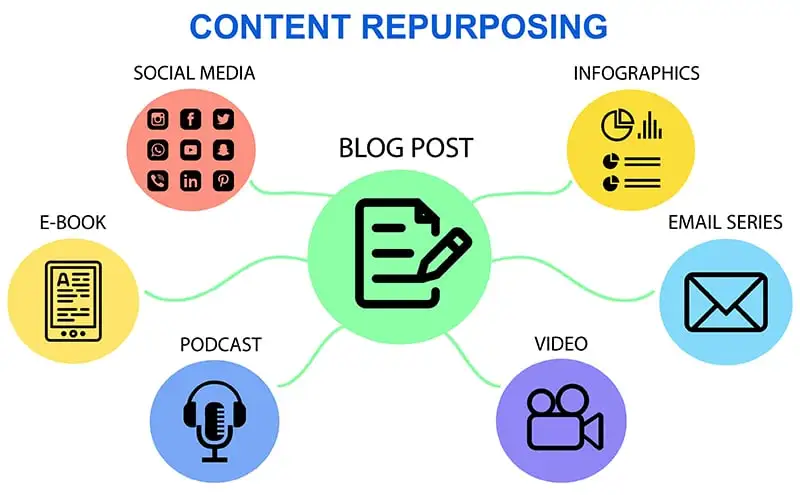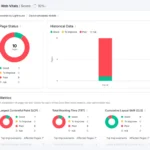
Creating new content consistently can be challenging, but did you know that your old blog posts can still drive significant traffic if repurposed correctly? Content repurposing is the process of taking existing content and transforming it into different formats or updating it to improve SEO performance. By doing this, you can maximize the value of your content, improve search rankings, and reach a wider audience.
Here’s a complete guide to repurposing content for SEO in 2025–2026.
1. Identify High-Performing Content
Start by analyzing your existing content to find posts that already attract traffic or backlinks.
Steps:
- Use Google Analytics to identify pages with high impressions, clicks, or engagement.
- Check Google Search Console for pages ranking on the second or third page—these have the potential to move up with optimization.
- Look for evergreen content that remains relevant over time.
Tip: Prioritize posts that already have some authority to maximize your SEO gains.
2. Update and Refresh Old Content
Google favors updated and relevant content. Refreshing old posts can improve rankings and user engagement.
What to update:
- Add new statistics, examples, or case studies.
- Update outdated information, links, and references.
- Optimize headings, meta descriptions, and images for current SEO best practices.
Tip: Even minor updates can result in noticeable traffic boosts.
3. Transform Content into Different Formats
Repurposing isn’t just about updating—you can repackage content in different formats to reach new audiences.
Examples:
- Turn a blog post into an infographic for Pinterest or social media.
- Convert long posts into short videos or reels for YouTube, Instagram, or TikTok.
- Create a podcast episode discussing the blog topic.
- Develop slide decks or downloadable guides for LinkedIn or your website.
Tip: Different formats cater to different audience preferences, increasing reach and engagement.
4. Optimize for SEO
When repurposing content, optimizing it for SEO ensures it continues to drive traffic.
SEO strategies:
- Focus on long-tail keywords related to the original topic.
- Add internal links to newer content to improve site structure.
- Ensure mobile-friendliness and fast loading speed.
- Use structured data or schema markup if creating new formats like videos or FAQs.
Tip: Avoid duplicate content by rewriting or reformatting the original material.
5. Promote Repurposed Content
Repurposing is effective only if the audience sees it. Promotion is key.
Promotion ideas:
- Share on social media platforms with different captions or visuals.
- Send updated content to your email subscribers.
- Collaborate with influencers or other bloggers in your niche.
- Submit infographics or guides to industry forums or platforms.
Tip: Repurposing allows you to reach audiences who may have missed the original post.
6. Measure Results and Adjust
Track the performance of repurposed content to see what works best.
Metrics to monitor:
- Organic traffic and ranking improvements
- Social shares, engagement, and click-through rates
- Leads, conversions, or sign-ups generated from the content
Tip: Continuous monitoring helps you refine your repurposing strategy and maximize ROI.
Conclusion
Content repurposing is a powerful SEO strategy that can breathe new life into old posts, improve rankings, and drive more traffic without creating entirely new content. By identifying high-performing posts, updating them, transforming formats, optimizing for SEO, promoting them, and tracking results, you can maximize the value of every piece of content on your website.
Start repurposing today and watch your old content generate fresh traffic and engagement like never before!
Frequently Ask Questions
1. What is the main goal of repurposing old content for SEO?
The main goal of repurposing content is to extend the life and reach of existing posts by presenting them in new formats or with updated information. This process helps improve search engine visibility, attract new audiences, and generate more organic traffic without starting from scratch.
2. How does content repurposing help improve search engine rankings?
Repurposing content helps strengthen your SEO by keeping it fresh, relevant, and optimized for new keywords. Updated or reformatted content signals to Google that your site is active, which can boost rankings and visibility.
3. Can repurposing content affect my website’s SEO negatively?
No, as long as you repurpose content correctly. Avoid copying and pasting the same text across multiple platforms. Instead, rewrite, reframe, or update the content to ensure it remains unique and relevant. Duplicate content can harm rankings if not handled properly.
4. What are the most effective formats for repurposing blog content?
Some powerful formats include videos, infographics, podcasts, eBooks, LinkedIn articles, slide decks, newsletters, and social media posts. Each format helps you reach audiences across different platforms, boosting your SEO reach.
5. How do I choose which old posts are worth repurposing?
Select posts that previously performed well in terms of traffic, engagement, or backlinks. Also, identify posts that cover evergreen topics—content that remains valuable over time and can be easily updated with fresh insights.
6. Is it okay to republish old articles on new platforms like Medium or LinkedIn?
Yes, it’s perfectly fine to republish on platforms like Medium or LinkedIn, but use canonical tags or modify the content slightly to avoid duplicate content issues. Republishing helps increase visibility and reach new readers.
7. Does Google consider repurposed content as duplicate content?
Google only considers it duplicate if you post the exact same version on multiple URLs. As long as the repurposed content is rewritten, updated, or presented differently (e.g., in video or infographic format), it’s considered unique.
8. How can I repurpose old posts without losing their existing rankings?
Keep the same URL and update the content within it, instead of creating a new post. Refresh titles, images, and keywords while maintaining the link structure and backlinks. This preserves the post’s authority and improves its ranking potential.
9. Can content repurposing increase backlink opportunities?
Yes, when you create new formats such as infographics, videos, or guest posts based on old content, you open doors for new backlink opportunities from other websites that find your updated content valuable.
10. How often should I repurpose old content for the best SEO results?
You can repurpose old content every 6–12 months depending on its performance. If the topic changes rapidly (like SEO trends or technology), updating more frequently—every 3–6 months—is recommended.
11. Should repurposed content target the same keywords as the original?
Not always. You can target related or long-tail keywords to expand your reach. For example, if your original post ranked for “content marketing tips,” your repurposed version could target “content marketing strategies for small businesses.”
12. Is there a difference between repurposing and rewriting content?
Yes. Rewriting means editing or improving the same blog post, while repurposing involves transforming it into new formats (like videos, podcasts, or guides) or tailoring it for new audiences.
13. Can I repurpose other people’s content legally and ethically?
You should never copy others’ content directly. However, you can take inspiration, add your own insights, cite original sources properly, and create a fresh version that offers unique value to your audience.
14. How does repurposing fit into a long-term content marketing strategy?
Repurposing helps maintain consistent publishing without constantly creating new content. It ensures that your best-performing pieces continue generating traffic and engagement, supporting sustainable long-term growth.
15. What tools can help automate the process of repurposing content for SEO?
Tools like Canva (for infographics), ChatGPT (for rewriting ideas), Lumen5 (for turning blogs into videos), Buffer or Hootsuite (for social sharing), and Google Analytics (for tracking performance) can make repurposing faster and more efficient.





